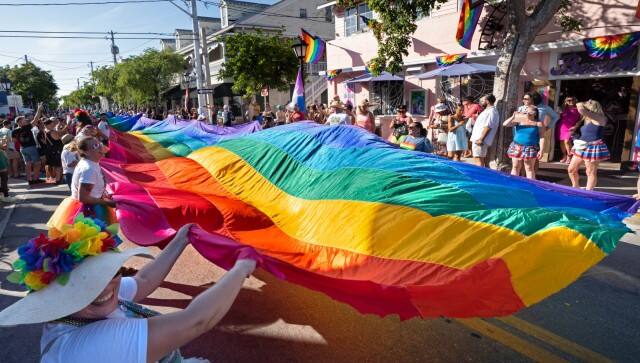It’s Pride Month and the celebrations have already begun around the world. As the LGBTQ+ community celebrates its rich history, accomplishments, and the current fight for equality, people from many backgrounds are joining forces. The classic rainbow flag is well known by now, but there is a more modernised version of it going around online. The brand-new flag is referred to as the “Intersex-Inclusive Progress Pride Flag.” The most recent iteration of the pride flag represents how awareness and acceptance of all sexual orientations and gender identities have evolved over time. Also read: Japan passes LGBT ‘understanding’ law: How it is out of sync with the country’s society, history The new “more inclusive” flag The famous rainbow flag was updated in 2021 for Pride Month to emphasise inclusivity within the LGBTQ+ movement. Intersex journalist and media figure Valentino Vecchietti was the driving force behind this new design, which sought to recognise and include intersex people, according to The Independent. People who are born with sex traits that do not correspond with conventional binary concepts of male or female bodies are referred to as “intersex.”
The new Pride flag is an improved version of existing inclusive banners that had been used in the past. Larger LGBTQ+ narratives have generally underrepresented the intersex. In 2021, Intersex Equality Rights (UK) decided to adapt the Pride Progress flag design to incorporate the intersex flag, creating the Intersex-Inclusive Pride flag. Intersex Equality rights activists did the redesigning. The colours yellow and purple are used in the intersex flag as a counterpoint to blue and pink which are traditionally seen as gendered colours, reported Indian Express. Also read: From Pine Cone to The Law of Love, 7 rainbow films to watch this Pride Month The colours representation
- Red: Life
- Orange: Healing
- Yellow: New Ideas
- Green: Prosperity
- Blue: Serenity
- Violet: Spirit
- Chevron Part
- Black and brown: people of colour
- White, blue and pink: transpeople
- Yellow with purple circle: Intersex people
Also read: Death penalty for gay sex in Uganda: The other horrible anti-LGBTQ laws across the world
Not the first time the flag is updated The rainbow-striped Pride flag, which has gained popularity over the past few years, has undergone revisions to reflect the intersectional diversity of LGBTQ+ communities. However, prior to the rainbow flag becoming well-known, these communities reportedly used other symbols, according to a report by the Los Angeles County Department of Mental Health. For instance, during the HIV/AIDS crisis, the pink triangle — which was based on the emblem used to punish gay prisoners in Nazi concentration camps — was extensively utilised. The Greek lambda symbol, blue feathers, purple handprints, green carnations, and ace playing cards were among the additional symbols. Harvey Milk, the first openly homosexual person to be elected to public office, asked his friend Gilbert Baker to design a symbol for the gay community in the late 1970s. The first rainbow-striped flag with eight colours was created by Baker with the help of Lynn Segerblom (also known as Faerie Argyle Rainbow), and it was unveiled in 1978 during the San Francisco Gay Freedom Parade, reported News18. According to the research, each colour has a symbolic connotation, with hot pink signifying sex, red signifying life, orange signifying healing, yellow signifying sunlight, green signifying nature, turquoise signifying magic and art, indigo signifying tranquilly, and violet signifying spirit. Due to issues with manufacturing and dying, the flag was later changed to a six-colour variant, giving rise to the well-known rainbow flag we all know today. [caption id=“attachment_12757832” align=“alignnone” width=“640”] Marchers in the Key West Pride parade carry a 100-foot-long section of an iconic 1.25-mile-long rainbow flag up Duval Street in Key West. AP[/caption] Although there are particular Pride flags for each identity within the LGBTQ+ group, the rainbow-striped flag is historically the one that is most associated with Pride for the entire community. The intersex flag was first designed in 2013 by Morgan Carpenter of Intersex Human Rights Australia, giving intersex people more visibility, according to The Independent. After that, in order to represent and integrate people of colour within the community, the Office of LGBT Affairs in Philadelphia in 2017, under the direction of civil rights activist Amber Hikes, added black and brown stripes to the rainbow flag. Daniel Quasar changed the flag’s colours to the transgender cause’s blue, white, and pink a year later. Transwoman Monica Helms created the original Pride Progress flag in 1999, wherein pink denotes femininity, blue denotes masculinity, and white denotes non-binarity. With inputs from agencies Read all the
Latest News
,
Trending News
,
Cricket News
,
Bollywood News
, India News
and
Entertainment News
here. Follow us on
Facebook
,
Twitter
and
Instagram
.
Marchers in the Key West Pride parade carry a 100-foot-long section of an iconic 1.25-mile-long rainbow flag up Duval Street in Key West. AP[/caption] Although there are particular Pride flags for each identity within the LGBTQ+ group, the rainbow-striped flag is historically the one that is most associated with Pride for the entire community. The intersex flag was first designed in 2013 by Morgan Carpenter of Intersex Human Rights Australia, giving intersex people more visibility, according to The Independent. After that, in order to represent and integrate people of colour within the community, the Office of LGBT Affairs in Philadelphia in 2017, under the direction of civil rights activist Amber Hikes, added black and brown stripes to the rainbow flag. Daniel Quasar changed the flag’s colours to the transgender cause’s blue, white, and pink a year later. Transwoman Monica Helms created the original Pride Progress flag in 1999, wherein pink denotes femininity, blue denotes masculinity, and white denotes non-binarity. With inputs from agencies Read all the
Latest News
,
Trending News
,
Cricket News
,
Bollywood News
, India News
and
Entertainment News
here. Follow us on
Facebook
,
Twitter
and
Instagram
.
)